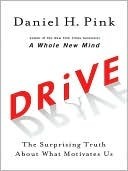More on this book
Community
Kindle Notes & Highlights
Read between
July 1 - July 4, 2022
“When money is used as an external reward for some activity, the subjects lose intrinsic interest for the activity,” he wrote.5 Rewards can deliver a short-term boost—just as a jolt of caffeine can keep you cranking for a few more hours. But the effect wears off—and, worse, can reduce a person’s longer-term motivation to continue the project.
Likewise, three German economists who studied open-source projects around the world found that what drives participants is “a set of predominantly intrinsic motives”—in particular, “the fun . . . of mastering the challenge of a given software problem” and the “desire to give a gift to the programmer community.”
It is inconceivable that people are motivated solely or even mainly by external incentives.”
“Intrinsic motivation is conducive to creativity; controlling extrinsic motivation is detrimental to creativity.”
In other words, the central tenets of Motivation 2.0 may actually impair performance of the heuristic, right-brain work on which modern economies depend.
The best use of money as a motivator is to pay people enough to take the issue of money off the table.
Only contingent rewards—if you do this, then you’ll get that—had the negative effect. Why? “If-then” rewards require people to forfeit some of their autonomy. Like the gentlemen driving carriages for money instead of fun, they’re no longer fully controlling their lives.
“We find that financial incentives . . . can result in a negative impact on overall performance.”6 On both sides of the Atlantic, the gap between what science is learning and what business is doing is wide.
What is true is that mixing rewards with inherently interesting, creative, or noble tasks—deploying them without understanding the peculiar science of motivation—is a very dangerous game.
Goals that people set for themselves and that are devoted to attaining mastery are usually healthy. But goals imposed by others—sales targets, quarterly returns, standardized test scores, and so on—can sometimes have dangerous side effects.
Glucksberg’s experiment provides the first question you should ask when contemplating external motivators: Is the task at hand routine? That is, does accomplishing it require following a prescribed set of rules to a specified end?
The essential requirement: Any extrinsic reward should be unexpected and offered only after the task is complete.
Human beings have an innate inner drive to be autonomous, self-determined, and connected to one another. And when that drive is liberated, people achieve more and live richer lives.
Ultimately, Type I behavior depends on three nutrients: autonomy, mastery, and purpose. Type I behavior is self-directed. It is devoted to becoming better and better at something that matters. And it connects that quest for excellence to a larger purpose.
Type I behavior emerges when people have autonomy over the four T’s: their task, their time, their technique, and their team.
One source of frustration in the workplace is the frequent mismatch between what people must do and what people can do. When what they must do exceeds their capabilities, the result is anxiety. When what they must do falls short of their capabilities, the result is boredom.
Our beliefs about ourselves and the nature of our abilities—what she calls our “self-theories”—determine how we interpret our experiences and can set the boundaries on what we accomplish.
how people spend their money may be at least as important as how much money they earn. In particular, spending money on other people (buying flowers for your spouse rather than a bauble for yourself) or on a cause (donating to a religious institution rather than going for an expensive haircut) can actually increase our subjective well-being.
Failing to understand this conundrum—that satisfaction depends not merely on having goals, but on having the right goals—can lead sensible people down self-destructive
Indeed, other economists have shown that providing an employee a high level of base pay does more to boost performance and organizational commitment than an attractive bonus structure.


